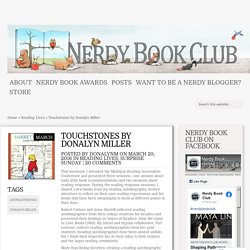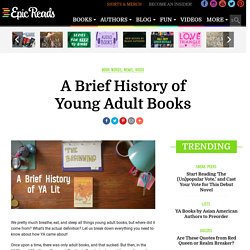

*Touchstones by Donalyn Miller. This weekend, I attended the Michigan Reading Association Conference and presented three sessions—one session about early 2016 book recommendations and two sessions about reading response.

During the reading response sessions, I shared a few books from my reading autobiography, invited attendees to reflect on their own reading experiences and list books that have been meaningful to them at different points in their lives. Robert Carlsen and Anne Sherrill collected reading autobiographies from their college students for decades and presented their findings in Voices of Readers: How We Come to Love Books (1988). *Stories StillMatter: Rethinking the Role of Diverse Children’s Literature Today. *The Atlantic What Does 'Young Adult' Mean? *Why So Many Adults Love Young Adult Literature. *How "Young Adult" Fiction Blossomed With Teenage Culture in America. Like jazz, the Broadway musical, and the foot-long hot dog, young adult literature is an American gift to the world, an innovative, groundbreaking genre that I’ve been following closely for more than 30 years.

Targeted at readers 12 to 18 years old, it sprang into being near the end of the turbulent decade of the 1960s—in 1967, to be specific, a year that saw the publication of two seminal novels for young readers: S. E. Hinton’s The Outsiders and Robert Lipsyte’s The Contender. Hinton and Lipsyte clearly were writing a new kind of novel for young adults—one of unsparing contemporary realism that met a need articulated by Hinton herself in a passionate article in The New York Times Book Review published on August 27, 1967. Here’s what she wrote: *Book Floods and Book Deserts. A Brief History of Young Adult Books. We pretty much breathe, eat, and sleep all things young adult books, but where did it come from?

What’s the actual definition? Let us break down everything you need to know about how YA came about! Once upon a time, there was only adult books, and that sucked. But then, in the 1940s and 50s, Nancy Drew and The Hardy Boys helped paved the way for modern YA which began to blossom in the 1960s. We put together this quick video to highlight young adult literature throughout the decades that help explain how YA lit has evolved to the massive, pop culture phenomenon it is today.
Young adult fiction is loved because it speaks to us all – unlike adult stories. It’s an easy win for a book critic.

Harry Potter, then Hunger Games, and now Divergent have dominated not just book publishing but popular culture for more than two decades. So after telling adult readers they should be ashamed to read children’s books, all Ruth Graham had to do was sit back and watch the outrage unfold. The Times film critic, AO Scott, took the same argument a step further this week by proclaiming the death of adulthood itself, with young adult fiction the leading symptom of a culture collapsing into permanent adolescence. Are You a Reader? Are you a reader?

Most people assume that teachers and librarians love books and reading, but, surprisingly, that isn’t always the case. My colleague, Teri Lesesne, and I decided to take advantage of the teachers and librarians we had in front of us during workshops to find out how they would answer this question. The Evolution of YA: Young Adult Fiction, Explained (Feat. Lindsay Ellis) Books by and/or about Black, Indigenous and People of Color (All Years) - Cooperative Children's Book Center. Children’s Books By and/or About Black, Indigenous and People of Color Received by the CCBC 2018-
